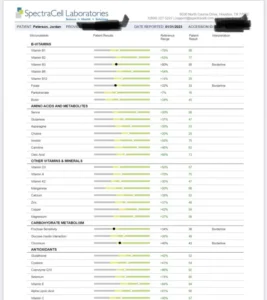SALT – I usually tell people when they first switch over to increase their intake of salt. This can help with muscle cramps. If you’re drinking tons of water though and incredibly thirsty, reducing salt might be a good idea.
As of August 27th, 2018, I’ve dropped salt!
Why on earth would I do such a thing? I love salt! Especially this salt: Real Salt

Welllll I read The Fat of the Land (which I loved. Will write a post on it eventually). Anyway, I found out the Inuit people didn’t salt their food or eat any salt (I assumed there was some sort of salted fish in their diet initially). So I dropped it out of curiosity.
I had assumed my muscle cramps from May were caused by low levels of salt (as increasing my salt intake had apparently resolved them). Now I’m not so sure.
I wanted to see if:
A) my muscle cramps would come back from lack of salt
B) if we actually even need salt in the diet to thrive
I was eating almost a tablespoon of pink Himalayan salt per day, and drinking almost 4L of water. I was really thirsty. My digestion also wasn’t ideal still (still occasional diarrhea).
For the first week after dropping salt, I had absolutely no appetite. Like, negative appetite. Everything tasted like nothing. Everything as in beef…. I went down from eating 2 pounds to eating about a pound of meat a day. There were a couple of days I had even less than that from zero appetite.
The salt cravings were really bad too. Week two still wasn’t good but by the end of it, I at least started to get hungry again. Week three meat started to taste okay. Not good. But manageable. I almost gave up week four because of the cravings but I’m always careful about cravings. I don’t think they’re a good sign. So I decided to give it the ol’ “six week try” just to see. I am currently finished six weeks and honestly haven’t seen a lot of difference. But I have seen some.
I’m drinking about 1.5L of water a day instead of almost 4L. That’s huge. I’m not nearly as thirsty. So I was definitely drinking a lot because of the amount of salt I was eating, and I think that was messing up my digestion, as my digestion is quite a bit more stable.
I’ll reintroduce it soon probably but my cravings are also almost gone so…. We’ll see. I don’t have an autoimmune response to salt obviously, but it’s interesting what you need and don’t need. ALSO – zero muscle cramps. I thought I would get them but nope! Which makes me think maybe I was drinking too much water in May and upsetting my electrolytes that way – which is why increasing my salt intake helped. But maybe reducing my water intake would have done the same thing?
I still miss salt though and will probably start eating it again. I’ll update this to see if anything changes.
Update December 2018: I’m still not eating salt. Cravings went away after about 6 weeks and it upsets my digestion if I eat it. I don’t really miss it.
UPDATE: 2023 – I eat salt. Be very careful that you’re eating pure salt, and bring your own salt to restaurants to avoid anti-caking agent present in most table salts.





Yes, salt is necessary to exist and thrive! And cravings for natural foods are the best tool of the body to show you what it needs! Please, do read about cribbing – if you crave salt you might be terribly deficient in essential minerals.
I’m not saying the amount you have been taking is the best for you, maybe not, but if you crave it, I’d dig into the deficiency sector 😉
I knew someone who gave up salt after awhile began the infections and skin rash. Salt is needed for the immune system and prevent chancre
Essential salts (Mg, Na, Ca etc) are sequestered in bone. You could be burning through your bodily stores, the cramps may come back in a few weeks/months. Just a thought.
This is interesting. I’m wondering if salt plays a role in the skin as well in terms of it’s healing capacity. I get dermatitis occasionally on my face and have some rawness where the skin simply doesn’t heal well…..I do add salt to pretty much everything I eat and drink. When I went full on carnivore I too was extremely thirsty. So I’m utterly confused now as to what to do regarding electrolytes, etc. ?♀️
I ditched the salt after I had transitioned over. It made things better.
It is difficult to imagine the earlier human used to drink water many times throughout the day. Water was not readily available for consumption like now. I think salt is like vitamin C. One needs less salt if he/she reduces water intake similar to like eliminating carbohydrate reduces the need for vitamin C. I guess, to flush out more offending molecules (due to consuming offending foods or having some kind of diseases), we need to drink more water. More water consumption will cause the elimination of more electrolytes through the pee. So, that causes an increased need for salt consumption. The increased salt consumption increases the amount of Sodium in the body. So one becomes thirsty so he/she/they/zee drink more water to dilute the sodium concentration in the blood. It is a vicious cycle. I think a carnivore fundamentally doesn’t need added salt. But at first, the vicious cycle has to be broken. To do this, gradually lowering salt consumption is the best idea. I guess the taste of food can be a good guide for this. For example, lets someone find that he needs to add 5 gm salt to his meat to make it best taste. Now, if he uses 4 gm of salt instead of 5 gm, he may find the meat is still tasty but if he uses 3 gm of salt then the food becomes unpalatable. So, he should use 4 gm salt. After several weeks of lower salt consumption, he may find that 3 gm of salt use makes the food tasty. This way we can use our taste to guide us to lower our salt consumption gradually.
Herbivores seek out salt licks. Elephants uproot trees to get at the salt between the roots. Carnivores neither seek salt nor sources of water. They are hydrated by their diet. However, they will lick a watermelon. I’ve seen tigers enjoying watermelon, because of the dopamine kick, probably. But the point is, it doesn’t appear that carnivores require salt beyond what they get in their natural diet of fatty meats.
My serum sodium and potassium were always high (above range high) and they went higher when I are mammal meat carnivore. when I switched to fish they were for the first time in my life in the middle range.
There is a lot of guessing and pseudoscience about why this happens when people go carnivore. I might have a better answer if anyone cares to discuss the science of it.
What sort of fish?
Love your writing but contrary to your experience, “high salt intake reduce thirst- not increases it”. Just run google search using the sentence in quotes. Here’s one link https://www.sciencedaily.com/releases/2017/04/170417182920.htm
None of those articles are based on a carnivorous diet so it’s hard to take them at face value. It definitely increased my thirst! Something people will need to test out themselves 🙂
My thirst definitely increased by adding salt to my beef. Even a small amount of salt does it.
I worry because of the increased incidence of osteoporosis found in inuit people who are carnivores. Something to do with leeching out calcium from bones.
There’s a connection between salt, mineral intake and osteoporosis for carnivores I ask?
I highly doubt it. We don’t have enough information obviously, but the disease among inuit people skyrocketed once they added carbs. They don’t follow a carnivorous diet anymore so aren’t a good example for disease in carnivores
The Inuit continue to be studied by nutritionists, including an on-going program by the Canadian government alarmed by the deteriorating health of the “white tent” Inuits whose western diet is killing them. The “tent” Inuits have a fondness for wheat flour and evaporated milk (which is heavily laced with sugar and carbs), and thus they ain’t doing so well either. The hunter/gatherer Inuits who stick to their traditional diet are doing just fine. Salt is an absolutely essential nutrient as everyone knows, but we don’t see tigers salting their prey.
Leave a comment